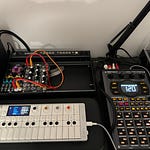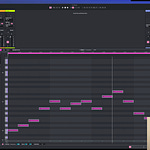This is not a jam, I repeat this is not a jam!
It’s more of a noodling around sesh.
I’m trying to create something of a template project in AUM with a set of my current favourite (they change from time to time) tools. Here for example I’ve got a few things loaded up in AUM, which I consider to be “Modular for iPad” or “iPad’s answer to Eurorack”.
The tools are Trooper synth for sound and it resembles classic analogue synth, Beat Scholar by Melodics, that features most heavily in this video and a bunch of effects plugins, I’ll come back to those in a moment and how I use them in a performance context. You’ll notice Dagger synth is in there too but that didn’t sound right with the other two, through no fault of the instrument but my setup of it.
I will come back to this project from time to time to get all of the other bits working and come up with something I could use in performance at the next ModCaf perhaps. Ooooh ambitious stuff.
The effects are super important, for example Cascade, which can be described as:
Cascade is a versatile reverb and diffusion processor with an experimental edge. Designed first and foremost with expansive modulated supernatural spaces in mind, it features an extensive set of controls to explore other sonic territories such as stereo widening, transient smearing, hybrid delay/reverb and chorus/flanger/resonator-like effects.
At its core, Cascade uses a chain, or cascade, of 24 allpass delay (a.k.a. allpass diffuser) stages for each of the left and right channels. Each of these stages smears and diffuses the incoming signal a bit, and chaining enough of these together results in a lengthy and diffuse reverberation effect. A notable feature of the allpass delay is its ability to produce various kinds of non-exponential responses, which works great for out-of-this-world effects like blooming and super long reverberation.
Now, this structure can sound somewhat static if allpass delay times are constant, so Cascade employs a randomized modulation scheme where each of the delay times is modulated by a dedicated LFO that is purposefully out of sync with others, thus adding a sense of motion to the sound.
Last but not least, Cascade incorporates a feedback loop around the entire chain, making infinite reverb and delay-infused diffusion textures possible. The feedback loop is complemented by damping filters to modify the frequency response over time.
It is a deep device, lots to explore here and sometimes works well with a secondary reverb, which sounds over the top but depends on what you’re processing.
In the video I play around with different presets but also five into adjusting the diffusion and shaping of the tail it creates.
Then I also use Glitchcore quite a lot too, for producing glitchy beats, reversing the beat and manipulating the beat on the fly. It’s great when you find those little sweet spots that sound so good and then switch back to the original dry beat. Developing a sense for this is highly rewarding when jamming live.
Beat Scholar is very impressive but I haven’t used it enough in my work, oh what a fool am I, it has to become a part of my toolkit right alongside Hammerhead which is an absolute classic.
I could go on, talking about this stuff forever, which in a sense, I will but a newsletter, podcast and video at a time.
If you haven’t yet, you’ve just stumbled upon this newsletter, then for goodness sake, subscribe! It makes sense, especially if you are into electronic music made on iPads and all of that. Yes especially you there!
Substack is a big place, but share this beyond, send it on a rocket into space, let’s get some alien subscribers or if you’re not a rocket scientist other humans will do just fine.
















Learning in public, seeing what works and what does not